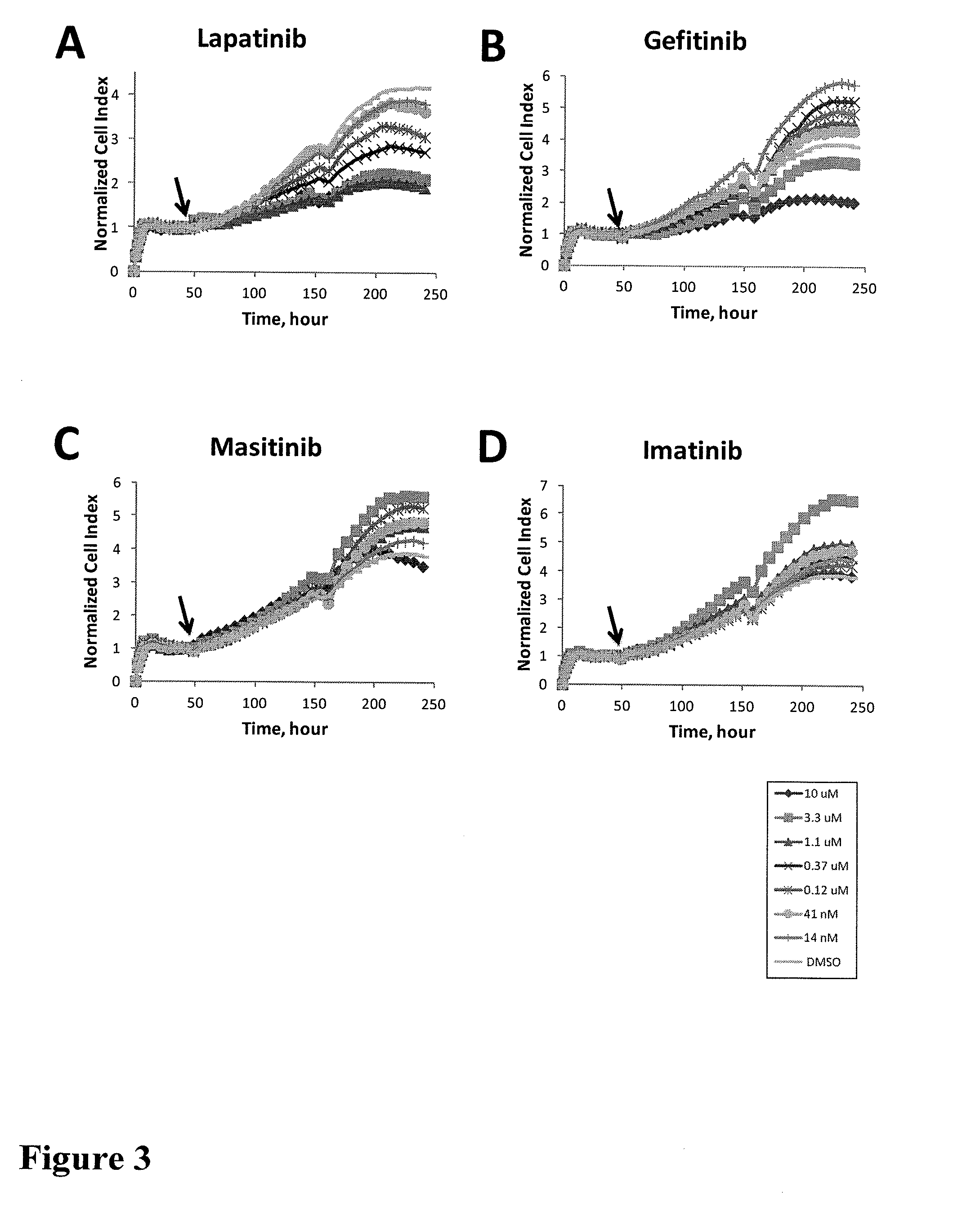Using impedance-based cell response profiling to identify putative inhibitors for oncogene addicted targets or pathways
a technology of impedance-based cell response and cell response profiling, which is applied in the field of cell-based assays, can solve the problems of tumor cell death growth inhibition and tumor cell apoptosis
- Summary
- Abstract
- Description
- Claims
- Application Information
AI Technical Summary
Benefits of technology
Problems solved by technology
Method used
Image
Examples
example 1
[0175]Met Addictive Cell Lines Show Characteristic Impedence-Based Time-Dependent Cell Response Profiles (TCRP) to Met Inhibition
[0176]Cell Lines.
[0177]Human lung cancer cell line H1993 and human gastric cancer GTL-16 overexpress cMET and are Met addicted cell lines. human melanoma cell line SK-MEL-28, human colon cancer cell line colo205, rat glioma cell line C6 are not addicted to cMET.
[0178]These cell lines were seeded into wells of 96 well E-Plate devices (Roche applied sciences) with an initial seeding density of 5000 cells per well and were pre-incubated in incubator under standard cell culture condition for about 24 hours. PF02341006 and ACEA348 (Met inhibitor) and other kinase inhibitors were added to the cells at different concentrations. The time-dependent cell response profiles (TCRP) were monitored prior to and after the compound addition using the xCelligence system (ACEA Biosciences / Roche applied sciences).
[0179]FIG. 1 and FIG. 4 show the TCRPs which are a representati...
example 2
[0181]PDGFR Addicted Cell Lines Show Characteristic Impedence-Based Time-Dependent Cell Response Profiles (TCRP) to PDGFR Inhibitors
[0182]Cell Lines.
[0183]Rat C6 glioma cell line is PDGFR addicted cell line.
[0184]C6 cells were seeded into wells of 96 well E-plate devices (ACEA Biosciences / Roche applied sciences) with an initial seeding density of 5000 cells per well and were pre-incubated in incubator under standard cell culture condition for about 24 hours. Kinase inhibitors including PDGFR inhibitors at different concentrations in DMSO were added into wells following the incubation period. The cell status was monitored prior to and after the compound addition using xCelligence system (Roche applied sciences). FIG. 8 shows the normalized cell index as a function of time prior to and after compound addition. The Cell index was normalized against the cell index values at a time point just before compound addition.
[0185]Upon PDGFR inhibitor treatment, C6 showed an initial increase (wi...
example 3
[0187]Monitoring Dose-Dependent Functional Activation of PDGFR / 3 in Rat Basophilic (RBL2H3) Cells and Pharmacological Characterization by a Selective PDGFR Inhibitor
[0188]Cell Lines.
[0189]RBL2H3-PDGFR is engineered rat basophilic cell line that expresses exogenous PDGFRβ. RBL2H3 is the parental cell line.
[0190]RBL2H3-PDGFR overexpressing PDGFR was constructed by Lenti viral transduction of RBL2H3. Both RBL2H3-PDGFR and RBL2H3 cells were seeded at 20,000 cells per well of 96-well E-plate (Roche / ACEA). The cells were continuously monitored using the xCelligence system (Roche / ACEA).
[0191]FIG. 12 shows the response of an engineered cell line, RBL-2H3 expressing PDGFRβ, to PDGF stimulation. Cells were serum starved for 2 hour, then stimulated by addition of PDGF BB (0-50 ng / ml). RBL-2H3 PDGFR showed an impedence-based TCRP to PDGF stimulation. Plotting the peak normalized CI response versus the corresponding log concentration allows for calculation of the EC50 (1.07 ng·mL) of PDGF acting...
PUM
 Login to View More
Login to View More Abstract
Description
Claims
Application Information
 Login to View More
Login to View More - R&D
- Intellectual Property
- Life Sciences
- Materials
- Tech Scout
- Unparalleled Data Quality
- Higher Quality Content
- 60% Fewer Hallucinations
Browse by: Latest US Patents, China's latest patents, Technical Efficacy Thesaurus, Application Domain, Technology Topic, Popular Technical Reports.
© 2025 PatSnap. All rights reserved.Legal|Privacy policy|Modern Slavery Act Transparency Statement|Sitemap|About US| Contact US: help@patsnap.com



